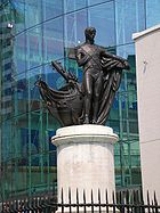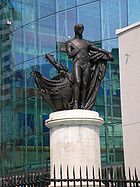
Statue of Horatio Nelson, Birmingham
Encyclopedia

Richard Westmacott
Sir Richard Westmacott, Jr., RA was a British sculptor.-Life and career:He studied under his father, Richard Westmacott the Elder, before going to Rome in 1793 to study under Antonio Canova...
, RA
Royal Academy
The Royal Academy of Arts is an art institution based in Burlington House on Piccadilly, London. The Royal Academy of Arts has a unique position in being an independent, privately funded institution led by eminent artists and architects whose purpose is to promote the creation, enjoyment and...
(1775–1856) stands in the Bull Ring, Birmingham
Birmingham
Birmingham is a city and metropolitan borough in the West Midlands of England. It is the most populous British city outside the capital London, with a population of 1,036,900 , and lies at the heart of the West Midlands conurbation, the second most populous urban area in the United Kingdom with a...
, England
England
England is a country that is part of the United Kingdom. It shares land borders with Scotland to the north and Wales to the west; the Irish Sea is to the north west, the Celtic Sea to the south west, with the North Sea to the east and the English Channel to the south separating it from continental...
.
Subscription
This bronze statue was the first publicly funded statue in Birmingham, and the first statue of Horatio NelsonHoratio Nelson, 1st Viscount Nelson
Horatio Nelson, 1st Viscount Nelson, 1st Duke of Bronté, KB was a flag officer famous for his service in the Royal Navy, particularly during the Napoleonic Wars. He was noted for his inspirational leadership and superb grasp of strategy and unconventional tactics, which resulted in a number of...
in Britain. It was made in 1809 by public subscription of £2,500 by the people of Birmingham
Birmingham
Birmingham is a city and metropolitan borough in the West Midlands of England. It is the most populous British city outside the capital London, with a population of 1,036,900 , and lies at the heart of the West Midlands conurbation, the second most populous urban area in the United Kingdom with a...
following Nelson's visit to the town on 31 August 1802, the year before he sailed against the fleets of Napoleon
Napoleon I of France
Napoleon Bonaparte was a French military and political leader during the latter stages of the French Revolution.As Napoleon I, he was Emperor of the French from 1804 to 1815...
. The statue was unveiled on 25 October 1809, that being the day decreed as the official golden jubilee
Golden Jubilee
A Golden Jubilee is a celebration held to mark a 50th anniversary.- In Thailand :King Bhumibol Adulyadej, the world's longest-reigning monarch, celebrated his Golden Jubilee on 9 June 1996.- In the Commonwealth Realms :...
of George III.
Description
Nelson stands in uniformUniform
A uniform is a set of standard clothing worn by members of an organization while participating in that organization's activity. Modern uniforms are worn by armed forces and paramilitary organizations such as police, emergency services, security guards, in some workplaces and schools and by inmates...
, with his one arm resting on an anchor with the prow of a miniature ship: HMS Victory
HMS Victory
HMS Victory is a 104-gun first-rate ship of the line of the Royal Navy, laid down in 1759 and launched in 1765. She is most famous as Lord Nelson's flagship at the Battle of Trafalgar in 1805....
. Upon the ship is the Flag Staff Truck (part of the mast) of the French ship Orient (1791)
French ship Orient (1791)
The Dauphin-Royal was an Océan class 118-gun ship of the line of the French Navy.During the French Revolution, she was renamed Sans-Culotte in September 1792, and eventually Orient in May 1795....
, flagship of the French fleet, sunk at the Battle of the Nile
Battle of the Nile
The Battle of the Nile was a major naval battle fought between British and French fleets at Aboukir Bay on the Mediterranean coast of Egypt from 1–3 August 1798...
. It originally stood on a cylindrical marble plinth
Plinth
In architecture, a plinth is the base or platform upon which a column, pedestal, statue, monument or structure rests. Gottfried Semper's The Four Elements of Architecture posited that the plinth, the hearth, the roof, and the wall make up all of architectural theory. The plinth usually rests...
carved with the people of Birmingham, surrounded by iron railings with lanterns standing on up-ended cannon at each corner.
The statue was originally erected on the site of the Old Cross, a two storey building (a meeting hall over an open space), built in 1703 and demolished in August 1784.
Since 25 April 1952 it has had Grade II* listed status.
The Statue was moved in 1961 during the first redevelopment of the Bull Ring and the carved plinth, cannon and lanterns lost. After the recent redevelopment has been moved back to close to its original location north of the church. It stands on the high balcony between the Bullring shopping centre and the new Selfridges store. Nelson now looks again over the church of St Martin in the Bull Ring
St Martin in the Bull Ring
The church of St Martin in the Bull Ring in Birmingham 5, England is a parish church in the Church of England.-Background:It is the original parish church of Birmingham. It stands between the Bull Ring shopping centre and the markets. The church is a Grade II* listed building. The current Rector...
. He now stands on a plain plinth, surrounded by iron railings linked by iron rope. These railings were the original railings, but were delayed from being installed by objections on the grounds of Health & Safety from the Bullring. However, the railings were restored in September 2005, just in time for the Trafalgar Bicentenary celebrations which centred on the statue.
The statue forms the centrepiece of Birmingham's annual Trafalgar Day
Trafalgar Day
Trafalgar Day is the celebration of the victory won by the Royal Navy, commanded by Vice-Admiral Horatio Nelson over the combined French and Spanish fleets at the Battle of Trafalgar on 21 October 1805. The formation of the Navy League in 1894 gave added impetus to the movement to recognise...
commemoration.
In 2009, to mark the 200th anniversary of the statue's unveiling, a medal was struck by St Paul's Mint of Birmingham.

